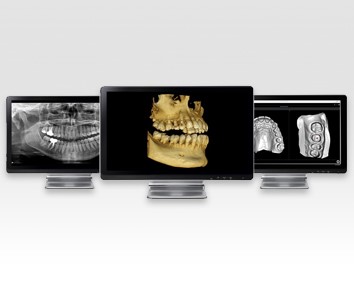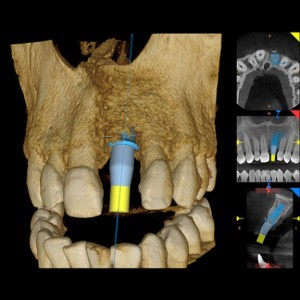Dental implants typically require extensive planning by the surgeon and your general dentist. Is most cases, using a combination of the clinical examination and careful review of your traditional 2-D dental images, i.e. Panoramic X-Ray or Peri-Apical X-Rays of the surrounding jaw and teeth, we are able to gather the majority of the needed information. However in many circumstances, these 2-D images may not be sufficient. This is where 3-D imaging is revolutionizing the treatment of dental implants.
We utilize the use of a combination 2-D / 3-D machine: The Carestream 8100 3D allows us to only obtain the 3-D imaging when needed, reducing your exposure to unnecessary RADs or Radiation.


The 3-D images are then used to determine the safest location for the placement of the dental implant. By having this information prior to surgery we are now able to plug this information into the latest innovation in implant treatment planning software. Using this software we are able to fabricate a surgical guide that will allow us to place the implant with proper surgical planning, down to 0.5mm! This helps to avoid any surprises during the procedure.
This is what we mean by “CT-guided Implant Placement”. The 3D imaging actually allows the procedure to be “performed” in advance of your surgery. A 3-D CT is obtained in our office, then using Anatomage we are able to place the implant or implants within the 3D mock-up of your dentition in the safest and most ideal positions. These implant positions can be shared in advance with your general dentist so that treatment is ideal.

For a single implant placement, this procedure can take less than one hour. This is where planning on our end, helps to save you time. Typically there are no incisions or sutures, leading to less post-operative swelling and discomfort. Most patients only take pain medication for the first few days, although you may be on short-course of antibiotics afterwards.
This state-of-the-art technology can be used for in patients needing 1 implant or 10 implants, in a full mouth rehabilitation case.
The power of 3D, without the complexity-High resolution, low radiation
By using cone beam CT technology, the CS 8100 3D produces a significantly lower radiation dose than the average CT system—making it a safe choice for patients. In addition, the unit’s four selectable fields of view and fast scanning mode confine radiation to the area of interest and reduce length of exposure for further safety. At the same time, the system delivers ultra-high resolution images at 75μm to ensure you have all the details you need to make an accurate and confident diagnosis—particularly for endodontic procedures.

Versatile Capabilities
- From traditional panoramic exams to endodontics, implant planning, and oral surgery applications, the CS 8100 3D is capable of much more than the average 3D unit.
- Award-winning 2D technology for superb panoramic images in seconds
- 2D and 3D images complement each other and enhance diagnostic abilities
- Accurate 3D representations ensure accurate diagnoses
Safer Examinations
The CS 8100 3D uses dental 3D technology to limit radiation dose and ensure safer exams.

- Confine radiation to area of interest with flexible fields of view
- Control size, resolution, and dose for each exam
- Adherence to the ALARA Principle helps you keep radiation exposure as low as reasonably achievable
- Dental 3D technology reduces exposure significantly more than conventional CT systems
Precision from All Angles
The CS 8100 3D is designed for accuracy, with a high-frequency X-ray generator, 4T CMOS sensor, and vibration-free motion system working together to ensure smooth image capture.
- Delivers sharp, contrasted images with resolution up to 75 μm
- 3D images offer more accurate views of patients’ dental anatomies
- View the area of interest from every angle, with one-to-one accuracy
- 3D images eliminates overlap and distortion

